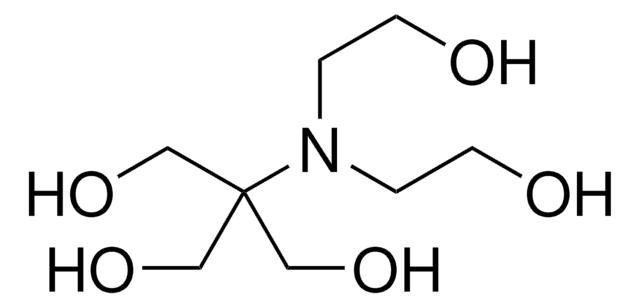RES1161B-A7
BIS-TRIS
Pharma Manufacturing
Synonym(s):
2,2-Bis(hydroxymethyl)-2,2′,2″-nitrilotriethanol, 2-Bis(2-hydroxyethyl)amino-2-(hydroxymethyl)-1,3-propanediol, Bis(2-hydroxyethyl)amino-tris(hydroxymethyl)methane
About This Item
Recommended Products
biological source
synthetic
Quality Level
form
powder
technique(s)
cell culture | mammalian: suitable
impurities
Endotoxin, microbial, and trace metals, tested
useful pH range
5.8-7.2
pKa (25 °C)
6.5
solubility
H2O: 0.1 M, clear, colorless (aqueous)
suitability
suitable for manufacturing use
foreign activity
Cytotoxicity, DNase, NICKase, RNase, and Protease; tested
SMILES string
OCCN(CCO)C(CO)(CO)CO
InChI
1S/C8H19NO5/c10-3-1-9(2-4-11)8(5-12,6-13)7-14/h10-14H,1-7H2
InChI key
OWMVSZAMULFTJU-UHFFFAOYSA-N
Looking for similar products? Visit Product Comparison Guide
General description
M-Clarity Program
Buffer quality is vital for the success of biopharmaceutical processes, because buffers are indispensable in nearly every production step.
Our broad portfolio of buffer materials manufactured under appropriate controls is tailored to your needs. Ranging from non-GMP grades for low-risk application, to IPEC-PQG GMP for higher-risk applications, we have products covering all your manufacturing needs.
Application
Bis Tris is used in a wide variety of biological applications including culture media, electrophoresis separations and diagnostic reagent formulations.
Packaging
RES1161B-A701X: 100g container
RES1161B-A702X 1kg container
RES1161B-A704X: 10kg container
RES1161B-A705X: 25kg container
Legal Information
replaced by
signalword
Warning
hcodes
Hazard Classifications
Eye Irrit. 2
Storage Class
11 - Combustible Solids
wgk_germany
WGK 1
flash_point_f
Not applicable
flash_point_c
Not applicable
Certificates of Analysis (COA)
Search for Certificates of Analysis (COA) by entering the products Lot/Batch Number. Lot and Batch Numbers can be found on a product’s label following the words ‘Lot’ or ‘Batch’.
Already Own This Product?
Find documentation for the products that you have recently purchased in the Document Library.
Customers Also Viewed
Our team of scientists has experience in all areas of research including Life Science, Material Science, Chemical Synthesis, Chromatography, Analytical and many others.
Contact Technical Service







